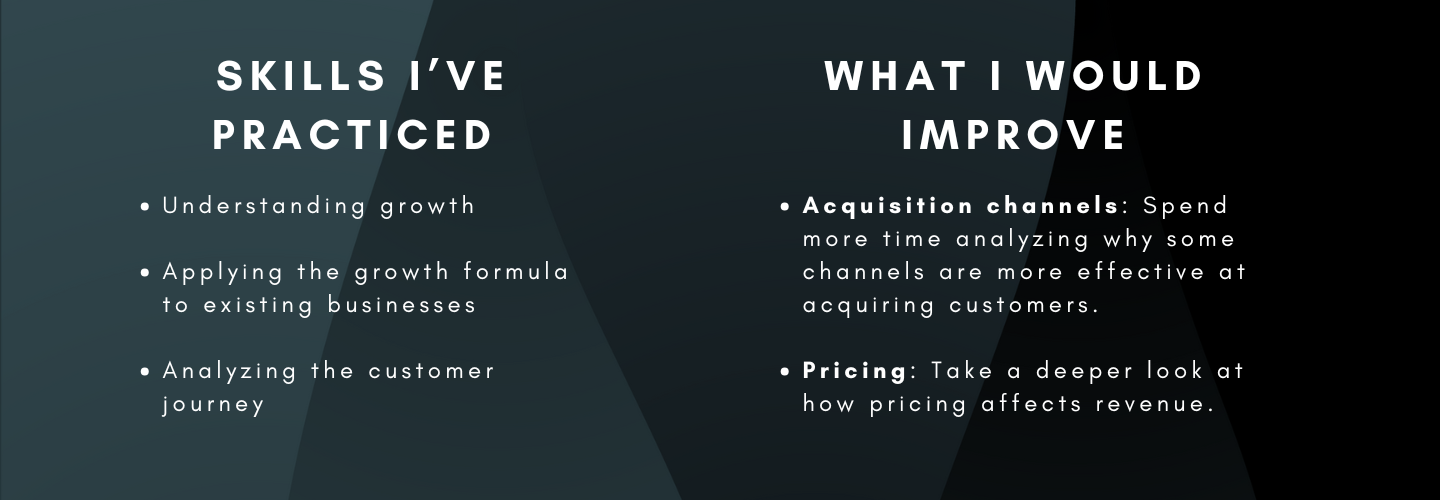Marketing: Growth and Analytics in One Month
Here is what one month of research and practice taught me about growth and analytics in marketing.
What is Growth?
It is important to understand what makes a business grow over time. The formula for understanding growth is:
F(X) = Y, where Function (X input) produces Y output.
Y = Value of the product <> how people pay you.
X breaks down into the following stages:
You can apply this formula to analyze any business by identifying how they achieve each step. For example:
Slack - F(X) = # of communities communicating using a paid plan
Awareness: People become interested in Slack and visit the website.
Acquisition: They sign up for a free account and collaborate via channels.
Activation: They upgrade to a paid account and grow their community.
Retention: Communities continue to communicate and engage with each other.
Revenue: Income from upgraded plans or features.
Referral: Users recommend Slack to other teams.
Check out other businesses I applied this to here.
Acquisition and Retention
To better understand business growth, I examined two critical stages: acquiring new customers and retaining current ones. I created a personal case study on how a company gained and maintained my business.
Some of the questions I sought to answer included:
What was the most effective acquisition channel? (Email marketing, social media ads, written content, etc.)
What immediately (within the first week) proved the product’s value to me?
What new habit did I form around the product that contributed to retention?
What long-term value reminders have I experienced?
Key Takeaways
Use psychological triggers: Tactics like social proof can move customers through the acquisition and retention stages.
Be honest: Long-term relationships with customers are only possible when the product delivers what it promises.
Reduce friction: Make it easy for customers to stay subscribed and continue using your product.
Encourage habits: Retention improves when customers form routines around your product.
Keep them engaged: Continue communication and interaction after acquiring a customer.
(Full case study here).
Optimization - Marketing Channels
When choosing how to market your product, you must consider which channels are optimal for your business. To demonstrate this decision-making process, I created a channel matrix for a fictional startup called "TechWiz".
What Are You Optimizing For?
Since you can’t optimize for everything, the first step is deciding your priority. In this case, I chose to optimize for learning. “TechWiz”, a productivity app, is in its early stages, so understanding the user base and how they engage with the app is crucial.
What are the constraints?
Here are the main factors I considered:
Target audience: Remote freelancers and digital nomads. Marketing efforts and channels must resonate with this specific group.
Budget limitations: Prioritize cost-efficient channels with a low CPA (cost per acquisition).
Limited team resources: With a small team, focus on channels that don’t require significant effort or extensive technical expertise.
Channel Matrix
Before selecting a channel, it’s important to evaluate how they compare. In a channel matrix, channels are listed in a column, and attributes (e.g., cost, targeting, input time) are listed across the top row. You can determine whether each channel ranks high, medium, or low for each attribute through research.
To align with the constraints, I eliminated channels that were:
Low in targeting
High in cost
High in input time
Additionally, I removed channels rated as High or Medium in output time to optimize for learning. From the remaining options, I chose two channels closest to the “ideal” based on the matrix. I ended up with:
SEM (Search Engine Marketing)
Facebook Ads
Tools I Used
Google Sheets: For creating the channel matrix
Google Docs: For documenting my thought process
Trello: Staying organized and meeting deadlines.
Grammarly: For grammar and clarity
Substack: Sharing weekly newsletters as I learn (check it out here)
LinkedIn: Sharing value-driven posts (Check out my LinkedIn here)




